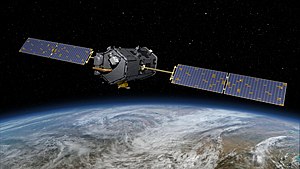 Artist depiction of OCO-2 | |
| Mission type | Climatology |
|---|---|
| Operator | NASA |
| COSPAR ID | 2014-035A |
| SATCAT no. | 40059 |
| Website | JPL OCO-2 Mission |
| Mission duration | 2 years (nominal) Elapsed: 10 years, 4 months, 14 days |
| Spacecraft properties | |
| Bus | LEOStar-2 |
| Manufacturer | Orbital Sciences[1] |
| Launch mass | 454 kg (1,001 lb)[1] |
| Dry mass | 409 kg (902 lb) |
| Payload mass | 131 kg (289 lb)[1] |
| Dimensions | Stowed: 2.12 × 0.94 m (6.96 × 3.08 ft)[1] |
| Power | 815 W[1] |
| Start of mission | |
| Launch date | 2 July 2014, 09:56:23 UTC |
| Rocket | Delta II 7320-10C |
| Launch site | Vandenberg, SLC-2W |
| Contractor | United Launch Alliance |
| Orbital parameters | |
| Reference system | Geocentric |
| Regime | Sun-synchronous |
| Perigee altitude | 701.10 km (435.64 mi) |
| Apogee altitude | 703.81 km (437.33 mi) |
| Inclination | 98.2° |
| Period | 98.82 minutes |
| Mean motion | 14.57 rev / day |
| Velocity | 7.5 km/s (4.7 mi/s) |
| Epoch | 19 September 2016, 10:55:06 UTC[2] |
| Revolution no. | 11,796 |
| Main telescope | |
| Type | Near-IR Cassegrain |
| Focal ratio | ƒ/1.8 [3] |
| Wavelengths | 2.06 microns 1.61 microns 0.765 microns[1] |
| Instruments | |
| 3 grating spectrometers | |

| |
Orbiting Carbon Observatory-2 (OCO-2) is an American environmental science satellite which launched on 2 July 2014. A NASA mission, it is a replacement for the Orbiting Carbon Observatory which was lost in a launch failure in 2009. It is the second successful high-precision (better than 0.3%) CO2 observing satellite, after GOSAT.
- ^ a b c d e f "Orbiting Carbon Observatory-2 Launch" (PDF) (Press Kit). NASA. July 2014. Retrieved 16 May 2015.
- ^ Peat, Chris (19 September 2016). "OCO-2 Orbit". Heavens-above.com. Retrieved 20 September 2016.
- ^ Osterman 2015, p. 7.